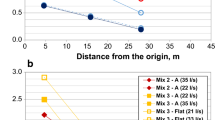Conclusions
-
1.
The most effective area of use in hydrotechnical construction of presently produced concrete-pumping plants with a pipeline diameter of 100–125 mm is structures where concrete with a maximum aggregate size not exceeding 40 mm is being placed (reinforced thin-walled structures: piers, conduits, powerhouses, tunnels, etc.).
-
2.
To use concrete pumps for placing massive concrete with an aggregate size greater than 80 mm, it is necessary to produce concrete pumps with a pipeline diameter greater than 250 mm.
-
3.
The effectiveness of using concrete pumping can be increased by using poured concrete mixes not requiring the traditional compaction in the block. Special investigations are needed for studying the characteristics of the technology of pumping such mixes.
Similar content being viewed by others
Literature cited
B. E. Kazantsev and V. I. Teleshev, “Evaluation of the effectiveness of measures to shorten the time of constructing massive concrete structures of hydro developments,” Gidrotekh. Stroit., No. 7 (1982).
V. I. Teleshev and V. K. Loshak, “Existing methods of concreting high concrete dams and ways to improve them,” Gidrotekh. Stroit., No. 10 (1982).
M. A. Lipovetskii, Concrete Pumps and Their Use in Hydrotechnical Construction [in Russian], Gosénergoizdat, Moscow-Leningrad (1963).
Manual on Placing Concrete Mixes by Concrete-Placing Plants [in Russian], TsNIIOMTP Gostroya SSSR, Narod. Predpriyat. Stroit. Montazh. Kombinata OST Minstroya GDR, Stroiizdat, Moscow (1978).
B. V. Zhadanovskii, A. G. Funikov, and Yu. B. Chirkov, “Some prospects of developing concrete pumping in the Eleventh Five-Year Plan,” Energ. Stroit., No. 12 (1981).
V. P. Folomeev, “Construction and operation of concrete-transporting lines,” Express Information. Energetics and Electrification, Series: Operation and Maintenance of Machines and Equipment for Power Construction [in Russian], No. 12 (1981).
M. A. Vertkina, N. N. Konstantinov, and A. P. Chemshit, “Use of concrete pumps in constructing nuclear power stations,” Energ. Stroit., No. 7 (1977).
M. I. Tsybul'ko, “Use of truck mixers and truck-mounted concrete pumps in the construction of nuclear power stations,” Energ. Stroit., No. 2 (1983).
V. A. Dorf and Yu. G. Khayutin, “Use of modern means of transporting and placing concrete in the construction of nuclear power stations,” Express Information. Energetics and Electrification, Series: Construction of Nuclear Power Stations [in Russian], No. 4 (1983).
J. Dallair, “Use of concrete with the addition of superplasticizer,” Civil Engineering. Engineering Structures and Environmental Protection [Russian translation], No. 1 (1983).
V. G. Batrakov, I. G. Metelitsyn, and V. R. Falikman, “Polyfunctional modifiers for poured concretes of high frost resistance,” Energ. Stroit., No. 10 (1983).
K. M. Korolev, “Improvement of the technology of pipe delivery of concrete,” Beton Zhelezobeton, No. 1 (1979).
Additional information
Translated from Gidrotekhnicheskoe Stroitel'stvo, No. 6, pp. 34–38, June, 1986.
Rights and permissions
About this article
Cite this article
Teleshev, V.I., Danilov, V.M. & Komarinskii, M.V. Prospects of using concrete pumping in hydrotechnical construction. Hydrotechnical Construction 20, 345–351 (1986). https://doi.org/10.1007/BF01424366
Issue Date:
DOI: https://doi.org/10.1007/BF01424366




